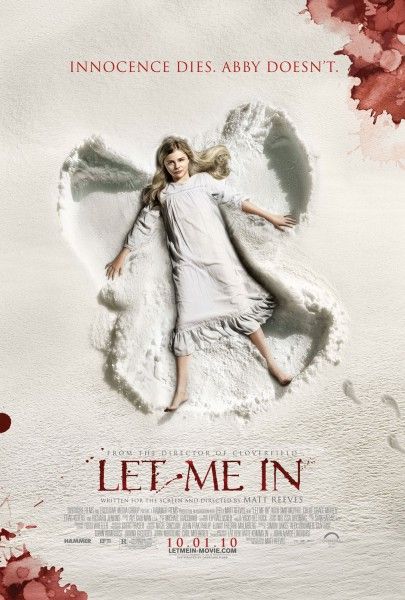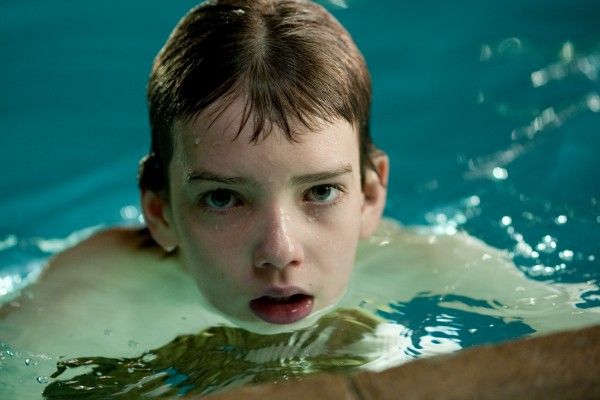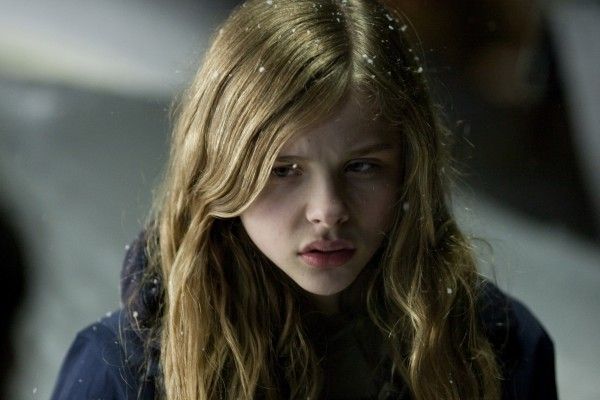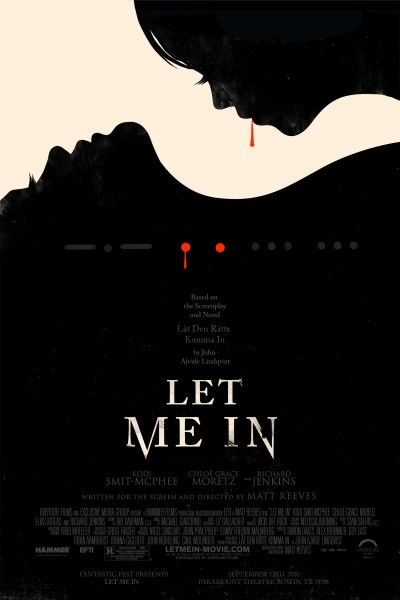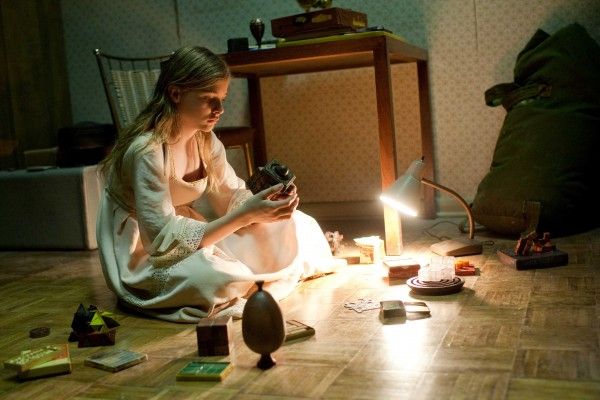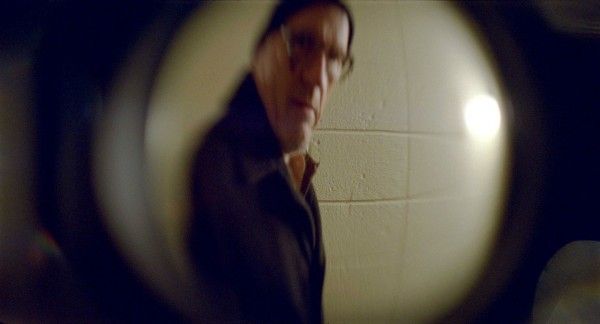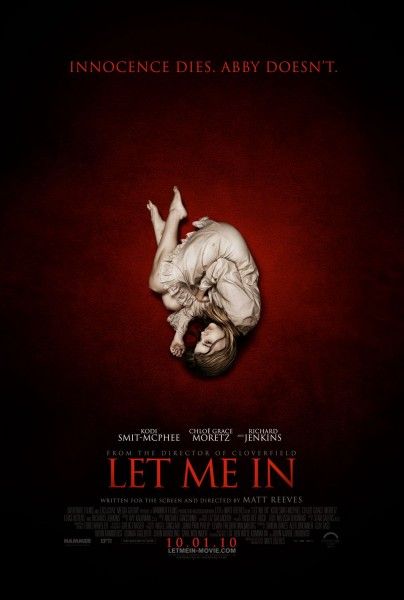Some of the most demanding challenges for a filmmaker are to adapt a novel for the screen, translate a foreign work for an English-speaking audience and to put their own mark on a remake without demeaning the original. Matt Reeves’ Let Me In manages to accomplish all three tasks.
The adolescent-centric vampire film, a remake of Swedish director Tomas Alfredson’s Let the Right One In, is an adaptation of the John Ajvide Lindqvist novel by the same name. Reeves’ Let Me In is actually less a remake and more a shot for shot tribute to the original with his own interpretations placed strategically throughout the film. To see how the American film differs from the original and just why this works, hit the jump.
For those who have seen Let the Right One In, this plot summary will seem like a carbon copy. However, there are changes, some subtle and some glaring. I’ll expand upon those shortly.
Let Me In opens with a frantic ambulance racing to the hospital. The paramedics radio in the condition of their patient, a man who apparently doused himself in acid. It’s a very different opening from Let the Right One In, which focuses on pleasantly falling snow. In this first scene, Reeves is already stating, “This is my version and it’s how we do things in America.â€
Once the patient arrives at the hospital, a police detective (Elias Koteas) interrogates him, although the man is heavily bandaged and cannot speak. The detective asks him if he is a Satanist and promises to catch whoever else he’s working with. As the detective is called out of the room for a phone call, a woman’s scream from the room sends him running back to find the suspect has fallen out of the window to his death. A scribbled note is left behind that reads, “I’m sory (sic) Abby.â€
Here we flashback two weeks earlier to the bleak little town of Los Alamos, New Mexico in the winter of 1983. A speech by Ronald Reagan is playing on a TV set, reminding Americans how inherently good we are, while the world around us is full of evil. We are introduced to Owen (Kodi Smit-McPhee), an isolated and introverted 12 year old boy who is dealing with his parents’ divorce and vicious bullies at school. In the sanctuary of his room, Owen dons a creepy mask and jabs at invisible assailants with a knife, repeatedly calling them a “little girl.†Owen then observes his apartment dwelling neighbors through a voyeuristic telescope. At this point, young Owen has all the characteristics of a budding serial killer.
Enter Abby (Chloe Moretz) and a middle-aged man listed only as “The Father,†played brilliantly by Richard Jenkins. They move into the apartment complex while Owen watches through his lens, only to discover that the strange, barefooted girl has been watching him as well. After an icy introduction between them, the 12-year-olds reach an accord and become friends. They gradually grow closer, meeting up at a small playground at night and communicating through their shared apartment wall through Morse code.
Meanwhile, Abby’s father dons a mask made out of a garbage bag and stalks a young man. He kills the man, strings him up and bleeds him dry, collecting the blood in a carboy. He becomes distracted and spills the blood, returning home empty-handed. When he shows up and admits his mistake, he is scolded by Abby’s inhuman voice, which Owen mistakes for the father himself.
Abby tricks a late-night jogger into helping her, as she masquerades as a poor, lost child. She feeds off of him, draining his blood. The father dumps the body into a lake to protect Abby. When they return home, he asks Abby to stop seeing Owen and she refuses.
Owen, meanwhile, is still dealing with an alcoholic mother and an absent father, whose voice he only hears briefly through the phone. The bullies at school are getting worse, to the point of scarring his face after whipping him with an antenna rod. Abby tells Owen he has to fight back, to “hit them harder than he dares.â€
Abby’s father goes out to collect blood for his vampiric daughter, only to screw up again and get trapped in the backseat of a car when his mark picks up an unexpected passenger. When the driver stops for gas, Abby’s father is spotted by the passenger. The father kills the other boy and then attempts to steal the car, but crashes spectacularly in the process. To avoid identification and to protect Abby, the father douses his own face in acid. The disfigured man is then rushed to the hospital. Abby hears this on the news and pays a visit to her father’s hospital room, by scaling the outer wall of the ten-story building. She drains him of his blood at his silent request, killing him before he falls to splatter on the sidewalk below.
Without the father’s interference, Abby and Owen grow closer still. She appears at Owen’s window that same night and he invites her in, asking her to be his girlfriend, which she accepts although she says she “is not a girl.†The next day, encouraged by his relationship with Abby, Owen stands up to the bullies and splits the ear of their leader Kenny (Dylan Minnette) with a metal pole. Luckily for Owen, he escapes trouble for the moment because the other students have found a dead body frozen in the lake.
Later that night, when Owen tells Abby about his fight, she approves and kisses him on the cheek. He attempts to make a blood pact with Abby, at which point she drops to the floor and licks the blood that had spilled from his wound. Though Owen sees Abby’s vampiric face, she does not attack him, but rather runs outside and attacks a woman, Virginia (Sasha Barresse) in the apartment complex. Virginia’s boyfriend Larry (Dylan Kenin) chases Abby off and rushes Virginia to the hospital.
Owen, afraid, seeks solace by calling his absent father. The call is short and one-sided, sending Owen further into isolation and despair. He goes to the only person he has left, Abby. She admits to needing blood to live and shows Owen pictures from her distant past. It quickly becomes clear that Abby’s “father†was actually once a boy like himself, a boy she met many years ago. Even though he aged, she remained the same. Owen flees the apartment out of fear and confusion.
Back at the hospital, the police detective learns from Larry that Abby was the one who attacked Virginia. Virginia, strapped to a hospital gurney, begins to gnaw on her arm, drinking the blood from her IV. When a nurse throws back the room’s curtains, Virginia bursts into flames, setting her, the nurse and the hospital room on fire.
Abby visits Owen when he is home alone. When she asks Owen to invite her in, he asks her why he has to say it. She answers by stepping into the room uninvited, immediately bleeding profusely. Owen invites her out loud and the bleeding stops. She says she knew he wouldn’t let her die. He lets her shower and gives her one of his mother’s dresses.
The next morning, the police detective breaks in to Abby’s apartment and finds her asleep in the bathtub, protected from the light by coverings on the windows. When he peels back the coverings to see, he burns Abby and wakes her up. Owen, who snuck in behind him, temporarily distracts the detective which allows Abby to kill him. Abby leaves that night. Owen cries as he watches her speed off in a taxi.
Owen, now completely alone, is swimming at the pool. Kenny’s older brother Jimmy (Brett DelBuono) sets a fire outside to distract the gym teacher and draw the rest of the kids out of the pool. Then, Jimmy holds Owen under water, telling him that if he can hold his breath for 3 minutes, he’ll only put a cut on his cheek. If he can’t, he’ll poke one of Owen’s eyes out.
Owen can’t hold out, but luckily for him, some avenging angel sweeps into the room and violently dispatches the bullies. Though the camera stays focused on Owen at all times, we see glimpses of the violence as kids are pulled rapidly through the water. Severed body parts fall in beside him and blood begins to contaminate the water around him. Owen surfaces to meet the eyes of his savior, Abby.
As they leave, snow falls into a bloodstained pool from a broken window high above. The film closes with a scene of Owen traveling on a train with a large trunk. Abby taps something in Morse code from inside of it and he answers with a tapping response of his own.
Now, if you made it all the way through the plot summary, you’ll remember that I mentioned the places where Let Me In diverged from Let the Right One In. Although Reeves’ has mentioned that he wanted to adapt the novel and not simply remake the movie, a lot of scenes are almost shot for shot. I mean A LOT of scenes. The initial blood-letting scene was nearly identical, although the Swedish version was more methodical, practical while the American version was framed in a more cinematic way. But the differences are what made both versions interesting.
We actually have a very good summary of these differences (also comparing the novel version) by our very own Bill Graham. Since I haven’t read the novel, I can’t speak to the accuracy, but it sounds somehow even darker and more graphic than either of the films. I’ll attempt to point out what I thought were the key points and why Reeves’ version works just as well.
First, the Swedish names and appearances of the children have been “Americanized.†Where the Swedish film featured a dark-haired Eli as the child vampire and a blonde-haired Oskar as the isolated youth, Let Me In switched physical traits and gave them good old fashioned American names. No big deal on first blush, but it changes an important plot point. More on that in a minute, but let me first get to our main characters.
Kodi Smit-McPhee might be the saddest kid on the planet and I mean that in the best possible way. After watching his performance in The Road and now in Let Me In, I can only hope he finds some cheerier roles in the future. Otherwise he might develop actually emotional issues. Chloe Moretz, on the other hand, takes a different turn from her role as Hit-Girl in Kick Ass. While confident and capable in each movie, she expresses a subtler, sweeter side of the violence that belies her character.
The addition of the police detective in Let Me In introduces a continuous thread throughout the film that wasn’t necessarily present in the original. In Let the Right One In, it’s the drunken boyfriend of the bitten woman that discovers Abby’s sleeping place. In Reeves’ version, we have more invested in the story and character at the point of his demise.
For a change that didn’t work for me, I have to mention the super-human scenes where Abby is “enhanced†through CG to show off her crazy vampire powers. They were a tad over the top. Just like the crazy cat attack in the original movie, these scenes would have been better off left on the cutting room floor.
But now for what is, in my opinion, the greatest departure from the original. Let the Right One In was intentionally ambiguous as to the gender of Eli, even if the book made it perfectly clear. What was supposed to translate across was the fact that Eli was actually a castrated boy, prior to being turned into a vampire. So, when Eli says “I’m not a girl,†she’s not saying “I’m a vampire,†she’s saying, “I used to be a boy.â€
However, in Let Me In, this fact is glossed over entirely. Chloe Moretz and the name Abby are not exactly ambiguous. Though she does often say, “I’m not a girl,†here it’s implied that she means, “Yeah, I’m actually a bloodthirsty vampire.†While it’s a subtle change in the styling between films, I think the Swedish version did a better job of layering a whole new level of “fucked up†to the plot. Honestly, I could write a full dissertation on every facet of this novel and the two films, but I recommend that you experience each of them in your own way.
Extras:
For answers from the man himself about what was included in the bonus features, check out this interview with Matt Reeves. Here’s a rundown of what you can expect when you buy Let Me In on Blu-ray.
First of all, the movie comes with a miniature comic book attached to the case. It’s issue 1 of 4 from Dark Horse comics and is a prelude to the film. The art is exceptional and it’s a nice little addition that adds some uniqueness to the package.
“From the Inside: A look at the making of Let Me In†is a behind-the-scenes featurette that shows the director’s and various cast members’ commentary over scenes taken throughout the course of filming. It traces the film’s progress from conception to final realization and touches on such topics as finding an American location to mimic the stark landscape of Sweden, the depth and range of the film’s actors and the minimal use of special effects throughout. The kid actors in this featurette are very charming, making the contrast of their roles in the film all the more striking.
There’s also the car crash sequence, which is a pretty amazing continuous take seen from inside the vehicle. It was an absolute highlight of the film, enough so that they included a separate feature showing the sequence step-by-step.
“The Art of Special Effects†obviously looks at the various inclusions of computer generated scenes within the film. As I already stated, it’s my opinion that these scenes actually take away from the realism of the movie. Taken out of context, that becomes even more apparent. While it’s cool to see Abby scaling the side of the hospital unassisted, the CG feels overdone in her attack sequences. Though, the breakdown of each scene gives you a good feeling of what it must be like to work as an animator. And I’ll admit, the “bursting into flames†scene is always a good sell.
“Car Crash Sequence: Step-by-step†takes you through the one-shot of the Father’s abduction and blood-letting gone wrong. In the film, it appears as if the Father crashes the car while speeding in reverse, sending him and his unconscious passenger tumbling down a hill side to rest upside down. The shot was achieved in two halves: one was using an actual stunt driver controlling the vehicle as it careened in reverse and the other used a car mocked up on a rotating rig. The whole scene was then blended by Method, using a CG animated landscape. It’s a pretty fantastic sequence in which the CG disappeared completely upon viewing.
There is also a picture-in-picture commentary exclusive to Blu-ray called “Dissecting Let Me In†that features additional information on each scene by the filmmakers.
The deleted scenes feature an option to have the commentary on or off. The first scene shows Abby pondering the Rubik’s cube that Owen lent to her. Another focuses on an extended conversation between Owen and the gym teacher, Mr. Zoric (Ritchie Coster) the only person Owen can talk to outside of Abby. The scene is a little too heavy on foreshadowing and takes away from Owen’s isolated state.
The last scene is the most disturbing, as Abby shows Owen what it was like when she was turned. In an attempt to make him understand how difficult it is to exist in her condition, he witnesses the violent moment when her vampiric suitor attacked her. It fit with the dramatic tone of the story, but perhaps took Abby’s status down a peg and put her on a closer level to Owen. I feel that leaving this scene on the cutting room floor was a good decision, as any attempt to humanize Abby’s character dilutes Owen’s devotion to her.
There is also a greenband and redband trailer for Let Me In, which are basically the same except for the appearance of blood in the redband. Also, there is a poster and still image gallery that shows of some promotional material and behind the scenes shots.


